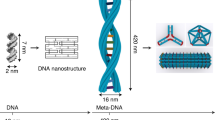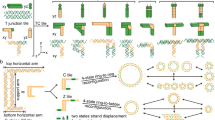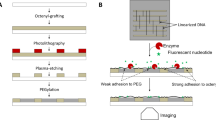Abstract
DNA nanotubes offer a high aspect ratio and rigidity, attractive attributes for the controlled assembly of hierarchically complex linear arrays. It is highly desirable to control the positioning of rungs along the backbone of the nanotubes, minimize the polydispersity in their manufacture and reduce the building costs. We report here a solid-phase synthesis methodology in which, through a cyclic scheme starting from a ‘foundation rung’ specifically bound to the surface, distinct rungs can be incorporated in a predetermined manner. Each rung is orthogonally addressable. Using fluorescently tagged rungs, single-molecule fluorescence studies demonstrated the robustness and structural fidelity of the constructs and confirmed the incorporation of the rungs in quantitative yield (>95%) at each step of the cycle. Prototype structures that consisted of up to 20 repeat units, about 450 nm in contour length, were constructed. Combined, the solid-phase synthesis strategy described and its visualization through single-molecule spectroscopy show good promise for the production of custom-made DNA nanotubes.
This is a preview of subscription content, access via your institution
Access options
Subscribe to this journal
Receive 12 print issues and online access
$259.00 per year
only $21.58 per issue
Buy this article
- Purchase on Springer Link
- Instant access to full article PDF
Prices may be subject to local taxes which are calculated during checkout





Similar content being viewed by others
References
Seeman, N. C. An overview of structural DNA nanotechnology. Mol. Biotechnol. 37, 246–257 (2007).
Aldaye, F. A., Palmer, A. L. & Sleiman, H. F. Assembling materials with DNA as the guide. Science 321, 1795–1799 (2008).
Lo, P. K. et al. Loading and selective release of cargo in DNA nanotubes with longitudinal variation. Nature Chem. 2, 319–328 (2010).
Dutta, P. K. et al. DNA-directed artificial light-harvesting antenna. J. Am. Chem. Soc. 133, 11985–11993 (2011).
Kuzyk, A. et al. DNA-based self-assembly of chiral plasmonic nanostructures with tailored optical response. Nature 483, 311–314 (2012).
Wei, B., Dai, M. J. & Yin, P. Complex shapes self-assembled from single-stranded DNA tiles. Nature 485, 623–626 (2012).
Wilner, O. I. et al. Self-assembly of DNA nanotubes with controllable diameters. Nature Commun. 2, 540 (2011).
Hamblin, G. D., Carneiro, K. M., Fakhoury, J. F., Bujold, K. E. & Sleiman, H. F. Rolling circle amplification-templated DNA nanotubes show increased stability and cell penetration ability. J. Am. Chem. Soc. 134, 2888–2891 (2012).
O'Neill, P., Rothemund, P. W. K., Kumar, A. & Fygenson, D. K. Sturdier DNA nanotubes via ligation. Nano Lett. 6, 1379–1383 (2006).
Yin, P. et al. Programming DNA tube circumferences. Science 321, 824–826 (2008).
Rothemund, P. W. K. et al. Design and characterization of programmable DNA nanotubes. J. Am. Chem. Soc. 135, 2864–2864 (2013).
Liu, D., Park, S. H., Reif, J. H. & LaBean, T. H. DNA nanotubes self-assembled from triple-crossover tiles as templates for conductive nanowires. Proc. Natl Acad. Sci. USA 101, 717–722 (2004).
Douglas, S. M., Chou, J. J. & Shih, W. M. DNA-nanotube-induced alignment of membrane proteins for NMR structure determination. Proc. Natl Acad. Sci. USA 104, 6644–6648 (2007).
Aldaye, F. A. et al. Modular construction of DNA nanotubes of tunable geometry and single- or double-stranded character. Nature Nanotech. 4, 349–352 (2009).
Hamblin, G. D. et al. Simple design for DNA nanotubes from a minimal set of unmodified strands: rapid, room-temperature assembly and readily tunable structure. ACS Nano 7, 3022–3028 (2013).
Zhang, Y. & Seeman, N. C. Construction of a DNA-truncated octahedron. J. Am. Chem. Soc. 116, 1661–1669 (1994).
Roy, R., Hohng, S. & Ha, T. A practical guide to single-molecule FRET. Nature Methods 5, 507–516 (2008).
Joo, C., Balci, H., Ishitsuka, Y., Buranachai, C. & Ha, T. Advances in single-molecule fluorescence methods for molecular biology. Annu. Rev. Biochem. 77, 51–76 (2008).
Weiss, S. Fluorescence spectroscopy of single biomolecules. Science 283, 1676–1683 (1999).
Karam, P., Ngo, A. T., Rouiller, I. & Cosa, G. Unraveling electronic energy transfer in single conjugated polyelectrolytes encapsulated in lipid vesicles. Proc. Natl Acad. Sci. USA 107, 17480–17485 (2010).
Ngo, A. T., Karam, P., Fuller, E., Burger, M. & Cosa, G. Liposome encapsulation of conjugated polyelectrolytes: toward a liposome beacon. J. Am. Chem. Soc. 130, 457–459 (2007).
Ha, T. et al. Probing the interaction between two single molecules: fluorescence resonance energy transfer between a single donor and a single acceptor. Proc. Natl Acad. Sci. USA 93, 6264–6268 (1996).
Ulbrich, M. H. & Isacoff, E. Y. Subunit counting in membrane-bound proteins. Nature Methods 4, 319–321 (2007).
Casanova, D. et al. Counting the number of proteins coupled to single nanoparticles. J. Am. Chem. Soc. 129, 12592–12593 (2007).
Jain, A. et al. Probing cellular protein complexes using single-molecule pull-down. Nature 473, 484–488 (2011).
Blunck, R., McGuire, H., Hyde, H. C. & Bezanilla, F. Fluorescence detection of the movement of single KcsA subunits reveals cooperativity. Proc. Natl Acad. Sci. USA 105, 20263–20268 (2008).
Harms, G. S. et al. Single-molecule imaging of L-type Ca2+ channels in live cells. Biophys. J. 81, 2639–2646 (2001).
Shu, D., Zhang, H., Jin, J. & Guo, P. Counting of six pRNAs of phi29 DNA-packaging motor with customized single-molecule dual-view system. EMBO J. 26, 527–537 (2007).
Ha, T. & Tinnefeld, P. Photophysics of fluorescent probes for single-molecule biophysics and super-resolution imaging. Annu. Rev. Phys. Chem. 63, 595–617 (2012).
Dempsey, G. T., Vaughan, J. C., Chen, K. H., Bates, M. & Zhuang, X. W. Evaluation of fluorophores for optimal performance in localization-based super-resolution imaging. Nature Methods 8, 1027–1036 (2011).
Huang, B., Wang, W., Bates, M. & Zhuang, X. Three-dimensional super-resolution imaging by stochastic optical reconstruction microscopy. Science 319, 810–813 (2008).
Rust, M. J., Bates, M. & Zhuang, X. W. Sub-diffraction-limit imaging by stochastic optical reconstruction microscopy (STORM). Nature Methods 3, 793–795 (2006).
Schmied, J. J. et al. DNA origami nanopillars as standards for three-dimensional superresolution microscopy. Nano Lett. 13, 781–785 (2013).
Acknowledgements
G.C. and H.F.S. are thankful to the National Science and Engineering Research Council of Canada and the Canada Foundation for Innovation. We are also thankful to Nanoquebec (G.C.), the Canada Institute for Health Research (CIHR) (G.C., H.F.S.) and the Canada Research Chairs program (H.F.S.). H.F.S. is a Cottrell Scholar of the Research Corporation. We are also thankful to the McGill CIHR drug-development training program (A.A.H. and Y.G.), GRASP and FRQNT (A.A.H.) and Vanier Canada (G.D.H.) for Graduate Scholarships.
Author information
Authors and Affiliations
Contributions
All authors contributed ideas, discussed the results and drafted the manuscript. A.A.H., G.C. and H.F.S. designed the study. G.C. and H.F.S. coordinated the study.
Corresponding authors
Ethics declarations
Competing interests
The authors declare no competing financial interests.
Supplementary information
Supplementary information
Supplementary information (PDF 1613 kb)
Rights and permissions
About this article
Cite this article
Hariri, A., Hamblin, G., Gidi, Y. et al. Stepwise growth of surface-grafted DNA nanotubes visualized at the single-molecule level. Nature Chem 7, 295–300 (2015). https://doi.org/10.1038/nchem.2184
Received:
Accepted:
Published:
Issue Date:
DOI: https://doi.org/10.1038/nchem.2184
This article is cited by
-
Improved immunoassay sensitivity and specificity using single-molecule colocalization
Nature Communications (2022)
-
Ultrasensitive electrochemical detection of hepatitis C virus core antigen using terminal deoxynucleotidyl transferase amplification coupled with DNA nanowires
Microchimica Acta (2021)
-
Encoding quantized fluorescence states with fractal DNA frameworks
Nature Communications (2020)
-
Programming chain-growth copolymerization of DNA hairpin tiles for in-vitro hierarchical supramolecular organization
Nature Communications (2019)
-
Multifunctional quantum dot DNA hydrogels
Nature Communications (2017)



